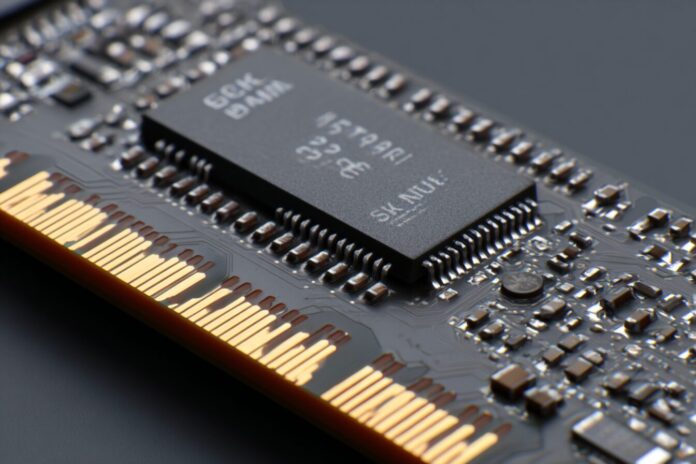SK hynix has recently confirmed the development of 3GB GDDR7 memory modules, a significant leap that promises to redefine the standards for next-generation GPUs. Most importantly, this breakthrough is not just about increasing memory capacity—it is about creating new possibilities for gaming, artificial intelligence, and high-performance computing. Because of this innovation, manufacturers can expect a transformation in GPU board designs accompanied by enhanced energy efficiency and cost control.
Furthermore, the integration of higher capacity modules paves the way for advanced graphics cards such as Nvidia’s highly anticipated RTX 50 Super series. Therefore, this technology may soon become a cornerstone for delivering superior performance while addressing the rising demands of modern software and advanced gaming environments.
The Next Generation of VRAM: Why 3GB GDDR7 Matters
The GPU industry has experienced an evolution in memory demands over the past decade. Modern gaming and creative applications consistently push VRAM usage to its limits. Because games and ray-traced graphics applications require seamless memory performance, the shift from 2GB to 3GB per chip represents a critical enhancement. This allows configurations such as 18GB or 24GB of overall VRAM with fewer chips, making board designs simpler and more efficient.
Most importantly, the increase to 3GB per module directly addresses past limitations, ensuring that gamers and professionals receive a smoother experience even during the most graphics-intensive tasks. Besides that, simpler module stacking reduces manufacturing complexity, as illustrated by detailed coverage on Tom’s Hardware. Therefore, the new memory modules not only boost performance but also streamline production and lower overall costs.
Enabling the RTX 50 Super Series VRAM Revolution
Industry insiders have been buzzing about the upcoming RTX 50 Super series, and the recent confirmation from SK hynix provides a solid technical foundation for these rumors. The innovative 3GB GDDR7 modules could enable GPUs to reach unprecedented VRAM levels, with configurations such as 24GB becoming feasible without compromising on board complexity. Because this development occurs in tandem with Nvidia’s technological advances, it is set to simplify the integration of high-capacity VRAM into cutting-edge graphics cards.
Moreover, multiple forums such as Overclock3D and ResetEra have discussed how these modules can lead to a lighter, more economically produced GPU. Therefore, the synergy between SK hynix and Nvidia suggests that the upcoming RTX 50 Super series may offer not only higher memory capacity but also a superior balance of performance and power efficiency.
Broader Impact on Gamers, Creators, and AI Users
The upgrade to 3GB GDDR7 modules provides tangible benefits across several key sectors. Most importantly, gamers will experience smoother gameplay at ultra settings, even with the most demanding ray tracing and high-resolution visuals. Because modern titles are increasingly resource-intensive, this enhancement is a crucial factor in delivering a lag-free and immersive experience.
Besides that, content creators and professionals who rely on GPU-accelerated applications will find that higher VRAM capacities reduce rendering times and improve real-time editing capabilities. In fields such as AI research and advanced simulation, more memory translates to enhanced compute performance. Therefore, as detailed discussions on HostZealot indicate, the shift to 3GB modules is critical for enabling future-proof systems across multiple industries.
Industry Trends: A Race Toward Higher Capacity and Speed
Recent developments from both SK hynix and Samsung emphasize the industry-wide push toward higher capacity memory solutions. Most importantly, as the demand for advanced VRAM increases, so does the need for innovations that ensure faster speeds and lower power consumption. Because newer modules require fewer chips to reach high capacities, manufacturers can offer GPUs that meet these strict requirements without a significant rise in production costs.
Furthermore, Fudzilla has covered how these product advancements will benefit both mainstream and premium segments of the market. In addition, this trend is supported by industry discussions that predict the democratization of next-gen memory technology, making high-capacity VRAM accessible to a broader array of consumers. Therefore, this shift is not just a technical milestone, but a strategic move to meet the diverse needs of gamers, creators, and professionals worldwide.
Competitive Advantage and Cost Efficiency
Adopting 3GB GDDR7 modules presents a competitive edge for GPU manufacturers by reducing the number of chips required on a single board. Because this reduction simplifies PCB design, manufacturers can enhance overall system reliability and lower the thermal overhead. Most importantly, fewer chips mean that power consumption is minimized, contributing to more cost-effective and environmentally friendly products.
Therefore, this method of integrating high-capacity modules not only boosts performance but also offers a strategic economic advantage. In a market where cost efficiency is as critical as raw performance, innovations like these underline the importance of balancing technical specifications with manufacturing realities. Besides that, end-users stand to benefit from reduced production costs, which could eventually lead to more affordable high-performance GPUs.
Looking Ahead: The GDDR7 Era
As we look towards the future, the adoption of 3GB GDDR7 modules is set to define the next era of GPU advancements. Most importantly, Nvidia and other leading GPU manufacturers are expected to integrate these modules into devices that cater not only to hardcore gamers but also to professionals in AI and high-performance computing. Because shipments are expected to begin later this year, we may witness the first consumer GPUs harnessing the power of these modules by the end of 2025 or early 2026.
Besides that, this transition marks the beginning of a broader trend towards greater VRAM capacities, improved energy efficiency, and more affordable upgrades in the GPU market. Therefore, as illustrated by recent industry analyses, both consumer expectations and technical specifications are set to evolve. In conclusion, SK hynix’s commitment to 3GB GDDR7 is a strategic advance that anticipates the shifting requirements of modern computing, ensuring that the next generation of graphics hardware will deliver unprecedented levels of performance.
Reference links:
Tom’s Hardware
Overclock3D Forums
ResetEra Forums
Fudzilla
HostZealot



